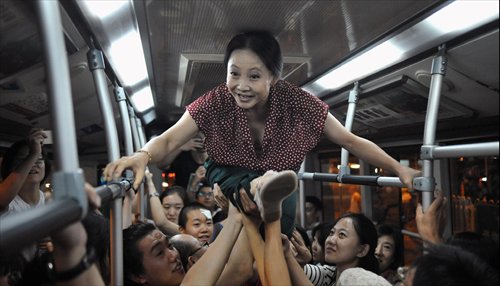Forging new paths
Experimental theater set to thrive after setbacks
Created in 1994, File Zero was about people's growth and boldly involved an actor using a welding machine to build a large-scale iron structure on the stage. The show made its debut in Europe and was shown more than 10 times overseas in the next two years, becoming a representative of Chinese experimental theater on the international stage.
"Many young theater artists don't know that there was already a number of very audacious theatrical experiments more than 10 years ago," Wang told the Global Times. "That's a reason I put on this exhibition."
Filling two floors of the former workshop of a paper-making machine factory, the exhibition offers an overall view of the development of Chinese experimental theater since the 1980s through videos of 88 productions created by 25 artists and four groups. The total length of the videos is about 125 hours.
Featured artists include Mou Sen, Meng Jinghui, Lin Zhaohua, Jin Xing, Wang Jianjun, Tian Qinxin and Zhang Xian from the Chinese mainland; Lei I-leong and Hui Koc-kun from Macao; and Danny Yung from Hong Kong.

Flourishing in the 1980s
In the late 1970s, many Western plays were translated into Chinese and influenced a group of playwrights to revolutionize scriptwriting in China. The starting point of Chinese experimental theater is seen by many as when Absolute Signal by Lin Zhaohua was first staged in 1982.
In the 1980s, experimental theater refreshed audience's experiences of the medium and promoted a flourishing in Chinese theater talent. But at the end of the 1980s and the beginning of the 1990s, experimental theater entered a difficult period, according to Qiu Zhijie, who co-curated the exhibition with Wang.
The reasons included not only that experimental theater didn't always stay on the right side of the mainstream propaganda, but also that it couldn't find enough investment to ensure its operation.
In the late 1990s, experimental theater took two different directions. One is represented by Meng Jinghui, whose work is both experimental and marketable; and the other is represented by Zhang Xian, who persists in a more underground approach with his avant-garde creations.
"Many China showcases appeared at small theater festivals, campus theater festivals and international theater festivals in this period. Meanwhile, a number of privately owned theater venues emerged, pushing Chinese experimental theater almost to a climax at the beginning of this century," said Wang.
In the past decade, more and more contemporary artists, many of whom studied abroad, have infused new blood in experimental theater by introducing contemporary dance, media art and performance art onto the stage, and even taking shows off the stage and into public arenas.
Different approaches
On view at the exhibition is media artist Feng Jiangzhou's work Floating City, Fleeting Life, which employs 3D images to generate interaction with actors during their performance, and Hou Ying's contemporary dance theater series that integrates body movements inspired by sound, sculpture, painting and video.
Real-time interaction between artist and audience has been another approach taken in experimental theater. In 25.3 km Fairy Tale, director Li Jianjun placed the performance on a moving bus, where audiences can watch and interact with the actors and can get on or off the bus at different stops at will.
There are also many dramatists who re-imagine classic stories and turn them into brand-new shows.
In Romeo and Juliet by Tian Qinxin, the graceful tragedy of Shakespeare turns into a musical theater performance full of pop culture; meanwhile Dream of the Red Chamber by Zhang Xian abandons the reserved features of the ancient Chinese classic and becomes a modern erotic tale.

(From top) Scenes from Floating City, Fleeting Life, and 25.3 km Fairy Tale Photos: Courtesy of Mingyuan Contemporary Art Museum
Uncertain future
"In China, the more experimental (a theater production is), the more audience (it will attract)," said Meng Jinghui in a trailer for the exhibition.
Meng has become one of China's most successful theater directors. His famous plays such as Rhinoceros in Love have regularly toured the country to widespread acclaim for decades.
"Meng's model can't be copied by others any more, as the times are different," said Wang. "I think that there will be theater artists as successful as Meng, but through using different methods maybe."
Nowadays with the flood of information and entertainment provided by the Internet, Wang believes that people's sensual experiences are greatly enriched, thus theater artists have to work even harder to attract a viable audience.
The overall revenue of dramatic arts in Beijing last year was 520 million yuan ($81.61 million), a 6 percent increase from 2013, according to figures from the Beijing Trade Association for Performances.
In contrast, in the booming film market, 10 Chinese films each earned a box office of 500 million yuan last year.
Shanghai's experimental theater experienced a loss when Mecoon Space, which used to nourish local experimental troupes, was closed at the end of 2013 due to economic pressure.
Fortunately, the recently opened Mingyuan Contemporary Art Museum hopes to fill the void by supporting experimental theater, and has already held 12 shows which attracted audiences of over 1,200 per show.
"I hope we can see more experimental theater productions in the city and in China. Many theater practitioners and I are confident about the future," said Wang.
Date: Until October 5, 10 am to 6 pm (closed Mondays)
Venue: Mingyuan Contemporary Art
Museum 明圆当代美术馆
Address: 436 Yonghe Road East
永和东路436号
Admission: Free
Contact info@mcam.io for more details